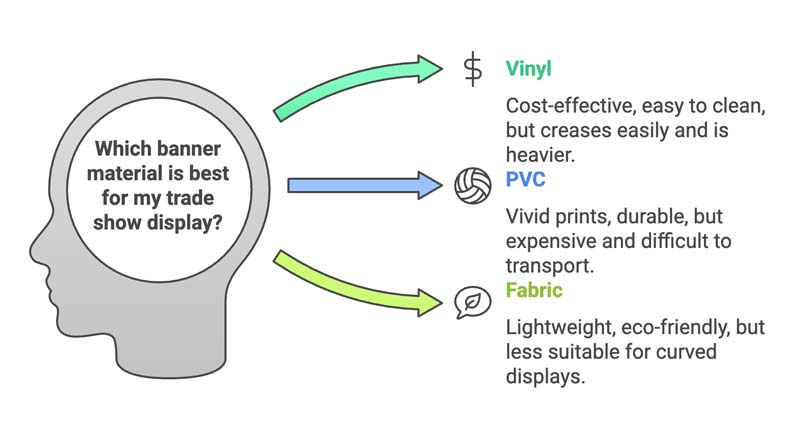Best Materials for Trade Show Banners: Pros & Cons of Each OptionAs the trade show industry evolves, so do the printing capabilities for large-format displays. Today, banners can be printed on a variety of materials, each offering distinct advantages and drawbacks. Choosing the right substrate for your trade show banner can significantly impact the look, portability, and durability of your display. Below, we break down the most popular banner materials and their pros and cons to help you make an informed decision.
 1. Vinyl BannersVinyl is a cost-effective and widely used material that delivers crisp, high-quality prints and is easy to clean. However, it creases easily, which can affect presentation. It is also heavier than other materials and has a common look that may not suit modern, high-end displays. Vinyl banners are best suited for straight, flat surfaces and work well in retractable banner stands. This makes them a great option for those who need a professional display without breaking the budget. The durability of vinyl ensures longevity, making it ideal for repeated use in multiple trade shows. If maintained properly, vinyl banners can last for years, providing exceptional value for exhibitors looking for a balance between affordability and durability. 2. PVC BannersPVC offers vivid, high-quality prints and is an excellent choice for curved display panels. It is also durable, making it a long-lasting option. However, PVC is more expensive than vinyl, difficult to transport due to its rigidity, and requires additional storage solutions. When properly stored in protective cases, PVC banners maintain their print vibrancy over time. Because of their smooth finish, these banners can showcase highly detailed designs, making them an excellent option for exhibitors who want to make a strong visual impression. The trade-off is the cost and transportation challenges, as they must be rolled rather than folded, requiring additional care and space when moving between trade show locations. PVC is often used in premium displays where visual impact is more important than portability. 3. Knit-Polyester Dye Sublimated Fabric BannersThis lightweight and travel-friendly material is wrinkle-resistant, and any wrinkles can be removed with water and hanging. The dye-sublimation process results in rich, long-lasting colors. However, fabric banners are less suitable for curved displays and may be more challenging to install in certain setups. Fabric banners are ideal for businesses that prioritize a sleek and modern appearance. Since the ink is embedded into the fibers rather than sitting on top, the graphics on fabric banners remain vibrant even after multiple uses. Another advantage of fabric banners is their eco-friendliness. Many trade show exhibitors opt for fabric banners as they can be reused without deterioration in quality, reducing waste compared to disposable alternatives. However, they may require more careful handling to prevent stains and fabric pulls. Choosing the Right Banner MaterialWhen selecting a trade show banner, consider your budget, portability needs, and desired aesthetic. Trade show banners come in various shapes, sizes, and materials, allowing you to find the best fit for your booth. Choosing the right substrate ensures a professional, eye-catching display that stands out at your event. Investing in the correct banner material can significantly impact the effectiveness of your trade show presence. Companies that require quick and frequent setups might lean towards fabric, while those who prefer striking visuals with long-term use may favor PVC. Vinyl remains a solid choice for affordability and ease of use. Evaluating the unique requirements of your display setup before purchasing ensures that your booth will look sharp and professional, leaving a lasting impression on potential clients and customers.
|